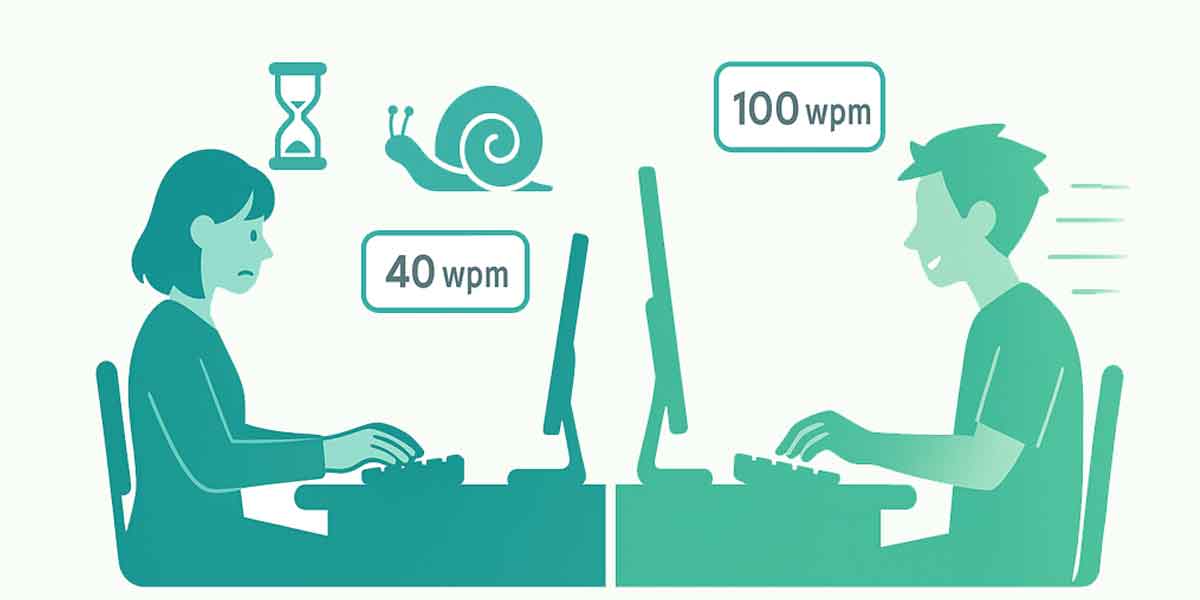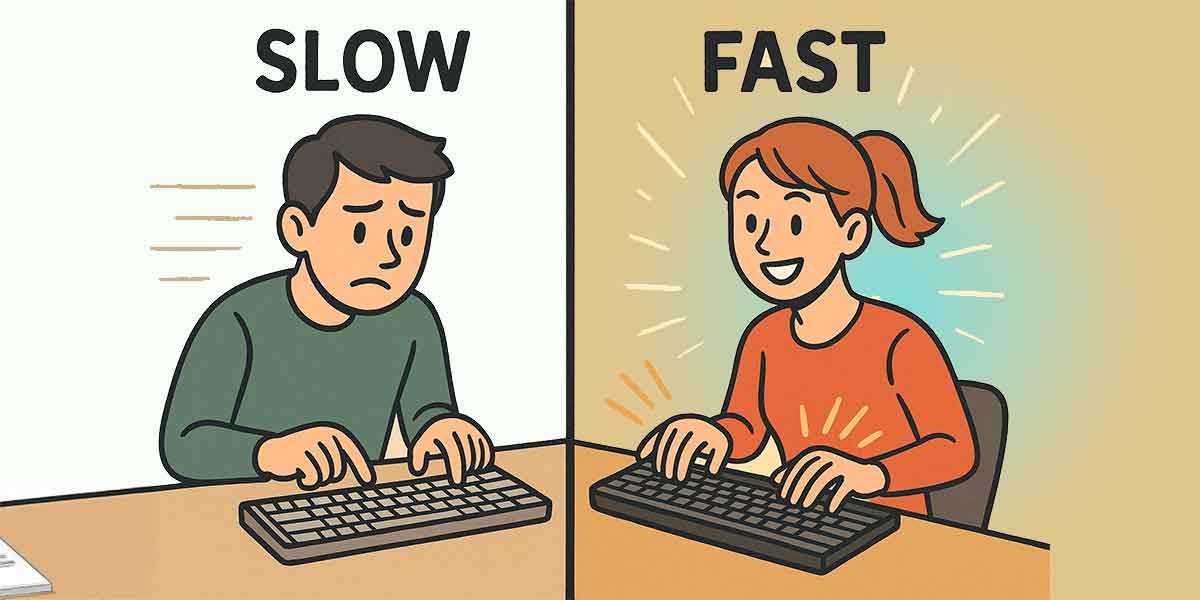はじめに:タイピングスキルの重要性
Introduction: Why Typing Skills Matter
私たちがパソコンを使って文章を作成したり情報を検索したりする際、入力速度や正確性は生産性と密接に結び付いています。一般的なオフィスワーカーには100文字/分(WPM)の入力が求められ、データ入力や音声書き起こしなど入力量の多い職種では100〜150 WPMと、より高い速度が必要とされます[1]。また、タッチタイピングの習得は時間短縮だけでなく、身体への負担軽減や仕事効率向上にも直結します。
Typing speed and accuracy are tightly linked to productivity in everyday computer work. Many office roles benefit from roughly 70–100 WPM, while data entry and transcription often require 100–150 WPM [1]. Mastering touch typing not only saves time but also reduces physical strain and improves overall workflow.
そこで本文では、タイピングの歴史、ブラインドタッチ(タッチタイピング)の起源と日本語入力の発展を概説し、正しい姿勢や練習法、ローマ字入力における母音・子音の習得ポイントを解説します。また、スキルを習慣化する心理学的アプローチを紹介し、なぜ本ウェブアプリを開発したのかという経緯に触れています。これらを通じて、誰もが効率的かつ楽しくタイピング能力を向上させられる環境を提供することを目指します。
This guide outlines the history of touch typing and the evolution of Japanese input, explains posture and training methods, highlights key points for learning vowels and consonants in romaji input, and introduces psychological approaches to habit formation. We also share why we built these web apps—to make skill‑building efficient and enjoyable for everyone.
1. ブラインドタッチの歴史とQWERTY配列の誕生
1. History of Touch Typing and the QWERTY Layout
1.1 タッチタイピングとタイプライターの誕生
1.1 Touch Typing and the Birth of the Typewriter
現代のキーボードに使われている QWERTY 配列は、19世紀にクリストファー・レイサム・ショールズが発明したタイプライターに由来します。ショールズは連続して使用される文字の位置を離すことで機械のハンマーが干渉しないように工夫し、1870年代初めにこの配列を完成させました[3]。初期のタイプライターはアルファベットの各キーを上から叩く構造で、連続入力による「絡み付き」が問題だったため、QWERTYは実用的な解決策として世界中に普及しました。1890年代にはタイピング学校も登場し、1915年ごろには公立学校でも指導が始まったと報告されています[4]。
The modern QWERTY layout traces back to 19th‑century typewriters by Christopher Latham Sholes. By separating frequently consecutive letters, the mechanism reduced typebar jams, and by the early 1870s QWERTY had taken shape [3]. Typing schools emerged in the 1890s, and public schools reportedly began instruction around 1915 [4].
1.2 ブラインドタッチの発明
1.2 The Emergence of Touch Typing
文字を見ずに打鍵するタッチタイピング(日本では「ブラインドタッチ」とも呼ばれる)は、米国の裁判所速記官フランク・エドワード・マッガリンによって1888年のタイピング競技で初めて公開されました[3]。彼はホームポジションに指を固定し、視線を手元から離したまま全ての指を使って打鍵する技法を披露しました。このメソッドは生産性の向上や身体的負担の軽減に繋がり、やがて世界中で標準的なタイピング技術となりました。
Touch typing—entering text without looking at the keyboard—was popularized by court stenographer Frank Edward McGurrin during an 1888 typing contest [3]. Anchoring the fingers on the home row and keeping the eyes on the text improved speed and reduced strain, and the technique soon became a global standard.
2. 日本語タイピングの歴史とローマ字入力
2. Japanese Typing and Romaji Input
2.1 日本語入力システムの発展
2.1 Evolution of Japanese Input Systems
日本語は漢字・ひらがな・カタカナの3種の文字体系を持つため、早期には専用の和文タイプライターが必要でした。杉本京太が1915年頃に発明した邦文タイプライターや、1972年のJIS C 6233(現在のJIS X 6002)規格で定められたかな配列など、数々の工夫が重ねられました[5][6]。しかし和文タイプライターはキー数が多く、高速入力が難しかったことから、ワープロ専用機が普及する1970年代まで一般的には浸透しませんでした。
Because Japanese uses kanji, hiragana, and katakana, early text entry relied on dedicated Japanese typewriters. Innovations included Kyota Sugimoto’s typewriter (~1915) and standardized kana layouts (JIS C 6233 in 1972, now JIS X 6002) [5][6]. Large key counts hindered speed, so widespread adoption lagged until word processors appeared in the 1970s.
1978年に東芝が発表した JW‑10 文字プロセッサーは、文節変換機能を備えた漢字かな変換を実装し、ローマ字やかな入力から目的の漢字に変換できるようになりました[7]。1980年代には親指シフトやM式といった独自配列が登場し、同年にはカナ入力モード時の読点などを定める規格が改訂され、現在の配列の基礎が完成しています[8]。
Toshiba’s JW‑10 (1978) implemented kanji‑kana conversion with phrase‑level processing, allowing users to input via romaji or kana [7]. The 1980s saw alternative layouts (e.g., thumb‑shift), and updates to standards helped establish today’s practical configurations [8].
2.2 ローマ字入力の登場と普及
2.2 The Rise of Romaji Input
ローマ字入力とは、アルファベットで日本語の音を打ち込み、漢字かな変換によって日本語テキストを生成する方法です。ルーツは1970年代後半のワープロ開発時代に遡り、初期には直接カナ入力が主流でしたが、パーソナルコンピュータの普及に伴いローマ字入力が人気となりました[7]。ローマ字入力方式には複数のローマ字表記法が関わっています。
Romaji input enters Japanese sounds using Latin letters and converts them into kana/kanji. Direct kana input dominated early word processors, but with the spread of personal computers, romaji became popular [7]. Several romanization systems influence practical typing methods.
2.2.1 ローマ字の歴史
2.2.1 A Brief History of Romanization
日本語をアルファベットで記す試みは17世紀、キリスト教宣教師が布教のために用いたラテン文字表記に始まります[9]。1867年に米国人宣教師ジェームス・カーティス・ヘボンが『和英語林集成』を刊行した際、自らのローマ字表記法(ヘボン式)を採用したことから広く知られるようになりました[10]。1885年には日本人学者らがローマ字会(ローマ字普及会)を結成し、ローマ字の標準化と普及を目指しました[10]。
Attempts to write Japanese with Latin letters date to 17th‑century missionaries [9]. James Curtis Hepburn popularized a romanization system through his 1867 dictionary [10], and Japanese scholars formed associations in the 1880s to promote standardization [10].
1940年代には田中館愛橘が考案した日本式ローマ字(後の訓令式)が文部省に採用されましたが、第二次世界大戦後の占領政策の下でヘボン式が道路標識などに用いられたため、現在はヘボン式が一般的です[11]。ワープロのキーボード入力のために考案されたワープロローマ字(和文ワープロ用ローマ字)が2000年にJIS X 4063:2000として標準化され、現在はローマ字入力の実用的なガイドラインとなっています[12]。
In the 1940s, the Ministry of Education adopted a Japanized system (later the Kunrei style), but postwar usage favored Hepburn on public signage [11]. For text entry, “Wāpuro romaji” was standardized as JIS X 4063:2000, providing practical guidelines [12].
2.2.2 ローマ字入力の仕組み
2.2.2 How Romaji Input Works
ローマ字入力では、アルファベットのキーボードを用いて日本語のモーラ(拍)を入力し、コンピュータがひらがなやカタカナに変換します。例えば「いま」は「2モーラ」、「テンポ」は「3モーラ」です。拗音を含む「シャツ」は「2モーラ」。「きょう」を表す場合は kyou と入力し、PCやスマートフォンの日本語入力システムが「今日」と変換します[9]。
With romaji, you type Japanese morae using Latin letters, and the IME converts them into kana or kanji. For example, type kyou to produce 「きょう」 and then convert to 「今日」 as needed [9].
- 母音: a, i, u, e, o に対応。ホームポジションと合わせて位置を体で覚える。
- 子音との組み合わせ: 例「か」= k + a、「し」= s + i。撥音「ん」は多くの環境で
nn が安全[9]。
- 小文字: 促音「っ」は直後の子音を2回(
tt 等)か x/ltu。拗音は lya/lya 系など[10]。
- Vowels: Map to a, i, u, e, o. Learn their positions relative to the home row.
- With consonants: e.g., 「か」 =
k + a; 「し」 = s + i. For 「ん」, nn is broadly safe across IMEs [9].
- Small kana: The sokuon 「っ」 doubles the following consonant (e.g.,
tt) or uses x/ltu; palatalized sounds use lya/lya‑type forms [10].
3. 正しい姿勢とホームポジション
3. Proper Posture and the Home Row
長時間のキーボード操作は手首や肩、背中に負担をかけるため、正しい姿勢と ergonomics(人間工学)を取り入れることが重要です。
Extended keyboard use can strain wrists, shoulders, and back, so ergonomics and posture matter.
- 椅子・机の高さ: 背筋を伸ばし、肘が90°程度。キーボードは肘より少し低く[11]。横から見た場合、膝は足首よりやや前に、両足は床へ[12]。
- 手と手首: 手首は曲げず軽くカーブ。手首を浮かせ、パームレストに体重をかけない[12]。肩と腕はリラックス、肘を開き気味に[11]。キーボードの「折りたたみ脚」は立てないのが無難。
- 視線とモニタ: 画面の高さを目線に合わせ、視線はキーボードでなく画面へ。ブラインドタッチ促進と首肩の緊張軽減に。
- Chair & desk height: Sit upright, elbows ~90°, keyboard slightly below elbow level [11]; knees slightly above ankles, both feet on the floor [12].
- Hands & wrists: Keep a gentle curve; avoid pressing weight into a palm rest [12]. Relax shoulders; keep elbows open [11]. Avoid propping keyboard feet.
- Gaze & monitor: Align the screen with your eye level and keep eyes on the screen, not the keys.
3.1 ホームポジションの理解
3.1 Understanding the Home Row
左手は F に、右手は J に人差し指。他の指は隣接キーを担当。突起(F/J)で視線を落とさず位置確認。母音キー(A・I・U・E・O)はホームに近いため、初心者はまず母音とホームの関係から始めると良いでしょう。
Place index fingers on F and J; other fingers cover adjacent keys. Use the tactile bumps on F/J to locate without looking. Since vowels (A I U E O) sit close to home, start by connecting vowels to their finger positions.
4. 練習の進め方 – 母音と子音を軸に
4. Practice Roadmap — Vowels and Consonants
4.1 ステップ1:母音の徹底練習
4.1 Step 1: Master the Vowels
すべての音節は母音が土台。まず A, I, U, E, O を無意識で押せるまで反復。本サイトのアプリ群でも母音重視の練習を主軸としています。母音だけの単語練習から短文へ進めましょう。
Vowels underpin every syllable. Drill A, I, U, E, O until they’re automatic. Our apps emphasize vowel‑first training: start with vowel‑only words, then short phrases.
4.2 ステップ2:子音別の練習
4.2 Step 2: Focus by Consonant Group
K → S → T … と行ごとに集中的に。音読しながらキー配置を結び付けます。注意点:
Train by consonant rows (K → S → T …), linking sound and position out loud. Notes:
- S行: shi(し)など英語読みと異なる綴りに注意。
- T行: chi(ち), tsu(つ)など特別な綴り。
- 濁音・半濁音: ba, pa などは B/P と母音の組み合わせ。
- S‑row: Watch special spellings like shi (し).
- T‑row: Note chi (ち) and tsu (つ).
- Voiced/semi‑voiced: Combine B/P with vowels for sounds like ba and pa.
4.3 長音・促音・撥音の練習
4.3 Long Vowels, Sokuon, and Nasal N
長音(ookii)、促音(matte)、撥音(konnichiwa)など日本語特有の表記を押さえる。促音「っ」は直後の子音を二重、撥音「ん」は次の母音で n / nn を使い分け[9][10]。
Handle Japanese specifics: long vowels (e.g., ookii), sokuon 「っ」 by doubling the following consonant (matte), and nasal 「ん」 as n/nn depending on the next sound [9][10].
5. 継続と習慣化の心理学
5. Consistency and the Psychology of Habits
練習を維持するには ハビット・ループ(刺激→行動→報酬)の設計が有効[13]。ポイントやバッジなど小さな報酬がドーパミンを介して学習を強化します[13]。反復は速度向上だけでなく自動化(automaticity)を進め、基底核にパターンが蓄積され認知的負荷が下がります[14]。日常の約40%は習慣的行動で占められるとも言われ[15]、短時間でも毎日の反復が鍵です。
A well‑designed habit loop (cue → routine → reward) sustains practice [13]. Small rewards such as points or badges reinforce learning via dopamine [13]. Repetition increases speed and promotes automaticity, reducing cognitive load as patterns consolidate in the basal ganglia [14]. Daily repetition—even brief—matters [15].
- 環境の固定: 同じ時間・場所で練習。環境の一貫性が形成を助ける[15]。
- 小さな目標: まずは「1分間ミスなく」から。
- ポジティブなフィードバック: スコア/バッジ/グラフで可視化し小さな進歩を称える[13]。
- Stable context: Practice at the same time/place to support habit formation [15].
- Small goals: For example, “one minute without errors.”
- Positive feedback: Visualize progress with scores/badges/charts [13].
6. 職業別タイピング速度の目安
6. WPM Benchmarks by Occupation
文章の内容で上下します。目標設定の参考に[1][2]。
Benchmarks vary with task complexity. Use these to set realistic goals [1][2].
| 職種 | 推奨入力速度 (WPM) | コメント |
|---|
| オフィスワーカー / 事務 | 70–100 | 一般的な資料作成やメール業務に十分。基本的なブラインドタッチ習得が望ましい。 |
| ソフトウェア開発者 | 80–110 | コード入力は語彙が特殊なため精度重視。ショートカットの活用も重要。 |
| カスタマーサポート / コールセンター | 50–70 | チャット対応や情報入力が多く、一定の速度と正確性が必要。 |
| データ入力 / 文字起こし | 100–150 | 大量のテキスト処理。姿勢管理と休憩が必須。 |
| 経営アシスタント / エグゼクティブセクレタリー | 70–100 | 高度なタイピングに加え、ビジネスマナーや文書力も求められる。 |
| ライター / 編集者 | 110–150 | 構成を考えながら入力。速度と柔軟な思考の両立。 |
| Role | Recommended WPM | Notes |
|---|
| Office / Admin | 70–100 | Sufficient for documents and email. Solid touch typing recommended. |
| Software Developer | 80–110 | Accuracy matters with specialized syntax; shortcuts help. |
| Customer Support / Call Center | 50–70 | Frequent chat and data entry require steady speed and accuracy. |
| Data Entry / Transcription | 100–150 | Heavy text throughput; manage posture and breaks. |
| Executive Assistant | 70–100 | Typing plus communication and documentation skills. |
| Writer / Editor | 110–150 | Balance speed with ongoing editorial thinking. |
7. ウェブアプリ開発の経緯と意義
7. Why We Built These Web Apps
筆者は長年にわたりパソコン初心者にタイピングを教える講習や研修を行ってきました。その過程で、多くの人が「自己流の入力方法のまま適正な速度に達しない」「正しい姿勢やホームポジションを知らない」「練習が続かない」といった課題に直面していることを痛感しました。市販ソフトは短期間で全キー習得を迫るものも多く、学習理論や心理学に基づく系統的教材は少ないのが現状です。
After years of teaching beginners, we saw common hurdles: self‑taught habits that cap speed, limited awareness of posture and home row, and difficulty sustaining practice. Many products rush full‑keyboard mastery, while few follow learning science and psychology.
そこで本サイトのウェブアプリでは、①歴史・理論を土台に母音/子音別コースや姿勢チェック、長音・撥音練習を段階設計、②日々の練習を記録し達成度に応じた報酬で習慣化を支援、③ブラウザだけで動き、アカウント不要で誰でも始められる――という設計思想を採っています。単なるゲームではなく、歴史と科学に裏付けられた教材です。
Our apps reflect three principles: (1) curricula grounded in history and theory—with vowel/consonant tracks, posture checks, and training for long vowels, sokuon, and nasal N; (2) habit support with logs and rewards; and (3) instant, account‑free access in the browser. Not just games—evidence‑informed learning tools.
参考文献
References
- What Is a Good Typing Speed for Employees and Why – TestGorilla
- What Is a Good Typing Speed for Jobs? – Success Performance Solutions
- History of Fast Typing and Old-School Techniques – Typesy
- Ancient History — The Rationale for Keyboarding Instruction Challenged (1989)
- Word Processing for the Japanese Language – ETHW
- タイピング界の歴史 – タイパー辞典
- A Short History of Romaji
- Wāpuro rōmaji – Wikipedia
- Hiragana - Japanese Typing Practice for Beginners
- Typing in Japanese – LingoDeer
- CUergo: Neutral Posture Typing
- 9 Tips for Proper Typing Posture – Typing.com
- How Are Habits Formed? – PositivePsychology.com
- The multiple effects of practice: skill, habit and reduced cognitive load – PMC
- Creating New Habits for Learning – Physiopedia
最終更新: 2025-09-23|BUILD_ID: YR-2025-0923-METHOD-K1
Last updated: 2025‑09‑23 | BUILD_ID: YR‑2025‑0923‑METHOD‑K1


